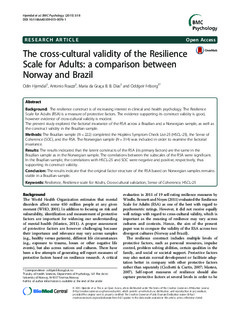| dc.contributor.author | Hjemdal, Odin | |
| dc.contributor.author | Roazzi, A. | |
| dc.contributor.author | Dias, M G | |
| dc.contributor.author | Friborg, Oddgeir | |
| dc.date.accessioned | 2015-06-20T13:14:04Z | |
| dc.date.accessioned | 2015-09-03T08:22:29Z | |
| dc.date.available | 2015-06-20T13:14:04Z | |
| dc.date.available | 2015-09-03T08:22:29Z | |
| dc.date.issued | 2015 | |
| dc.identifier.citation | BMC Psychology 2015, accepted paper | nb_NO |
| dc.identifier.issn | 2050-7283 | |
| dc.identifier.uri | http://hdl.handle.net/11250/298527 | |
| dc.description.abstract | Background: The resilience construct is of increasing interest in clinical and health psychology. The Resilience Scale for Adults (RSA) is a measure of protective factors. The evidence supporting its construct validity is good, however evidence of cross-cultural validity is modest. The present study explored the factorial invariance of the RSA across a Brazilian and a Norwegian sample, as well as the construct validity in the Brazilian sample.
Methods: The Brazilian sample (N = 222) completed the Hopkins Symptom Check List-25 (HSCL-25), the Sense of Coherence (SOC), and the RSA. The Norwegian sample (N = 314) was included in order to examine the factorial invariance.
Results: The results indicated that the latent constructs of the RSA (its primary factors) are the same in the Brazilian sample as in the Norwegian sample. The correlations between the subscales of the RSA were significant. In the Brazilian sample, the correlations with HSCL-25 and SOC were negative and positive, respectively, thus supporting its construct validity.
Conclusion: The results indicate that the original factor structure of the RSA based on Norwegian samples remains stable in a Brazilian sample. | nb_NO |
| dc.language.iso | eng | nb_NO |
| dc.publisher | BioMed Central | nb_NO |
| dc.title | The cross-cultural validity of the Resilience Scale for Adults: A comparison between Norway and Brazil | nb_NO |
| dc.type | Journal article | nb_NO |
| dc.type | Peer reviewed | en_GB |
| dc.date.updated | 2015-06-20T13:14:04Z | |
| dc.source.volume | 3 | nb_NO |
| dc.source.journal | BMC Psychology | nb_NO |
| dc.source.issue | 18 | nb_NO |
| dc.identifier.doi | 10.1186/s40359-015-0076-1 | |
| dc.identifier.cristin | 1247243 | |
| dc.description.localcode | © 2015 Hjemdal et al. This is an Open Access article distributed under the terms of the Creative Commons Attribution License (http://creativecommons.org/licenses/by/4.0), which permits unrestricted use, distribution, and reproduction in any medium, provided the original work is properly credited. The Creative Commons Public Domain Dedication waiver (http://creativecommons.org/publicdomain/zero/1.0/) applies to the data made available in this article, unless otherwise stated. | nb_NO |
